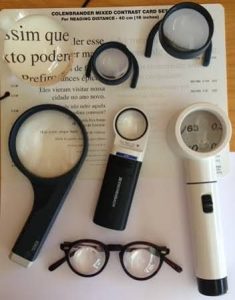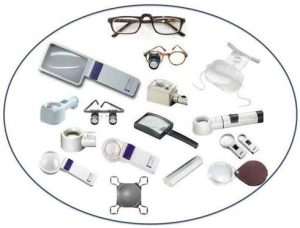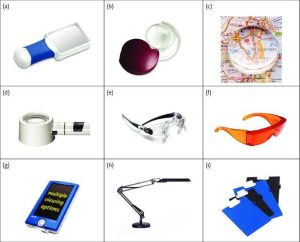Low vision magnifiers are devices designed to help individuals with visual impairments maximize their remaining vision. These tools can significantly enhance daily life by providing clear and manageable information.
Types of Low Vision Magnifiers
- Handheld Magnifying Glasses: Portable and lightweight, these magnifiers are ideal for reading small print, labels, and menus. They come in various magnification strengths (2x to 10x) and are suitable for individuals with macular degeneration, cataracts, or general low vision.
- Desktop Electronic Magnifiers: These stationary devices project enlarged images onto a screen, allowing users to read documents, view photos, and see objects with enhanced clarity. They’re perfect for extended reading sessions and can help individuals with macular degeneration, diabetic retinopathy, and glaucoma.
- Wearable Magnifying Glasses: Hands-free magnification makes these glasses ideal for tasks requiring precision, such as hobbies or cooking. They’re customizable and provide consistent magnification, enabling users to engage in everyday activities with confidence.
- Digital Portable Magnifiers: Compact and lightweight, these devices are perfect for on-the-go reading and writing. They often feature adjustable zoom and color contrast options, making them suitable for individuals with various visual impairments.
- Electronic Magnifiers: These high-tech devices incorporate digital enhancements like contrast adjustment, brightness control, and text-to-speech features. They’re designed to assist individuals with severe visual impairments and can be used for reading, writing, and other daily tasks.
Benefits of Low Vision Magnifiers
Low vision magnifiers can ¹ ² ³:
- Enhance visual clarity and readability
- Increase independence and confidence
- Facilitate daily tasks, such as reading, writing, and cooking
- Improve overall quality of life
Popular Brands and Products
Some notable brands and products include ⁴ ⁵ ⁶:
- Vision Buddy: A wearable magnifying device with a high-resolution display and hands-free design
- Amigo Portable Low Vision Electronic Magnifier: A simple-to-use device with a 6.5-inch viewing screen and adjustable magnification
- Pebble HD: A compact and lightweight portable magnifier with a 4.3-inch screen
- Zoomax Luna: A portable video magnifier with a range of magnification options and high-definition display
- HumanWare Prodigi: An all-in-one PC with electronic video magnification capabilities
Where to Find Low Vision Magnifiers
You can find low vision magnifiers at specialized stores, online marketplaces, or through low vision services and resource centers. It’s essential to consult with a low vision specialist to determine the best type of magnifier for your specific needs






